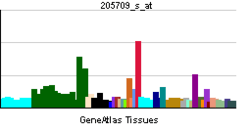CDS1 (gene)
| View/Edit Human | View/Edit Mouse |
Phosphatidate cytidylyltransferase 1 is an enzyme that in humans is encoded by the CDS1 gene.[3][4][5]
Function
Breakdown products of phosphoinositides are ubiquitous second messengers that function downstream of many G protein-coupled receptors and tyrosine kinases regulating cell growth, calcium metabolism, and protein kinase C activity. This gene encodes an enzyme which regulates the amount of phosphatidylinositol available for signaling by catalyzing the conversion of phosphatidic acid to CDP-diacylglycerol. This enzyme is an integral membrane protein localized to two subcellular domains, the matrix side of the inner mitochondrial membrane where it is thought to be involved in the synthesis of phosphatidylglycerol and cardiolipin.[6][7] and the cytoplasmic side of the endoplasmic reticulum where it functions in phosphatidylinositol biosynthesis. Two genes encoding this enzyme have been identified in humans, one mapping to human chromosome 4q21 (this gene) and a second (CDS2) to 20p13.[5]
References
- ↑ "Human PubMed Reference:".
- ↑ "Mouse PubMed Reference:".
- ↑ Halford S, Dulai KS, Daw SC, Fitzgibbon J, Hunt DM (Jan 1999). "Isolation and chromosomal localization of two human CDP-diacylglycerol synthase (CDS) genes". Genomics. 54 (1): 140–4. doi:10.1006/geno.1998.5547. PMID 9806839.
- ↑ Weeks R, Dowhan W, Shen H, Balantac N, Meengs B, Nudelman E, Leung DW (Apr 1997). "Isolation and expression of an isoform of human CDP-diacylglycerol synthase cDNA". DNA Cell Biol. 16 (3): 281–9. doi:10.1089/dna.1997.16.281. PMID 9115637.
- 1 2 "Entrez Gene: CDS1 CDP-diacylglycerol synthase (phosphatidate cytidylyltransferase) 1".
- ↑ M. Nowicki & M. Frentzen (2005). "Cardiolipin synthase of Arabidopsis thaliana". FEBS Letters. 579 (10): 2161–2165. doi:10.1016/j.febslet.2005.03.007. PMID 15811335.
- ↑ M. Nowicki (2006). "Characterization of the Cardiolipin Synthase from Arabidopsis thaliana". Ph.D. thesis, RWTH-Aachen University.
Further reading
- Kimura K, Wakamatsu A, Suzuki Y, et al. (2006). "Diversification of transcriptional modulation: large-scale identification and characterization of putative alternative promoters of human genes.". Genome Res. 16 (1): 55–65. doi:10.1101/gr.4039406. PMC 1356129
 . PMID 16344560.
. PMID 16344560. - Gerhard DS, Wagner L, Feingold EA, et al. (2004). "The status, quality, and expansion of the NIH full-length cDNA project: the Mammalian Gene Collection (MGC).". Genome Res. 14 (10B): 2121–7. doi:10.1101/gr.2596504. PMC 528928
 . PMID 15489334.
. PMID 15489334. - Strausberg RL, Feingold EA, Grouse LH, et al. (2003). "Generation and initial analysis of more than 15,000 full-length human and mouse cDNA sequences.". Proc. Natl. Acad. Sci. U.S.A. 99 (26): 16899–903. doi:10.1073/pnas.242603899. PMC 139241
 . PMID 12477932.
. PMID 12477932. - Liu Y, Virshup DM, White RL, Hsu LC (2002). "Regulation of BRCA1 phosphorylation by interaction with protein phosphatase 1alpha.". Cancer Res. 62 (22): 6357–61. PMID 12438214.
- Volta M, Bulfone A, Gattuso C, et al. (1999). "Identification and characterization of CDS2, a mammalian homolog of the Drosophila CDP-diacylglycerol synthase gene.". Genomics. 55 (1): 68–77. doi:10.1006/geno.1998.5610. PMID 9889000.
- Lykidis A, Jackson PD, Rock CO, Jackowski S (1998). "The role of CDP-diacylglycerol synthetase and phosphatidylinositol synthase activity levels in the regulation of cellular phosphatidylinositol content.". J. Biol. Chem. 272 (52): 33402–9. doi:10.1074/jbc.272.52.33402. PMID 9407135.
- Heacock AM, Uhler MD, Agranoff BW (1996). "Cloning of CDP-diacylglycerol synthase from a human neuronal cell line.". J. Neurochem. 67 (5): 2200–3. doi:10.1046/j.1471-4159.1996.67052200.x. PMID 8863531.
